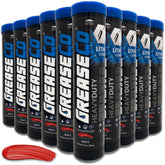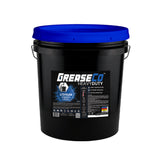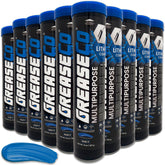What is a standard size grease tube?
A standard USA grease tube contains 14 ounces or 396.89 grams of lubricating grease. Internationally 400 grams and 14.1 ounces is common fill weights for grease tubes.
Grease tubes are essential tools throughout a wide range of industries, automotive, construction, maintenance, and industrial sectors. Grease tubes are specifically designed to hold and dispense grease efficiently, making lubrication tasks more manageable. In this article, we will delve into various types of grease tubes, while touching on their key features and benefits.
Key Features and Benefits of Grease Tubes
-
Precision Dispensing & Pressure
- Grease tubes are designed with precision dispensing in mind. The narrow nozzle allows for accurate application of grease, while introducing pressure to allow grease to follow into critical hard to reach areas. This ensures proper lubrication is targeted to specific components.
- Benefit: This feature saves both time and money by minimizing excess grease usage and avoids messy handling or imprecise applications.
-
Easy Handling and Portability
- Grease tubes are typically compact and lightweight, making them easy to handle and transport. They can be stored in toolboxes and transported to job sites with relative ease in comparison to other grease packaging styles.
- Benefit: This portability ensures that you have access to lubrication wherever it's needed, whether in the workshop, on a job site, or during a vehicle maintenance task.
-
Durable Construction
- Most grease tubes are constructed from sturdy materials that protect the grease from contamination and ensures the longevity of the lubricant. This also protects the grease from picking up contaminates such as dust or debris along the way, which would wreak havoc on vital equipment parts.
- Benefit: The durable construction of grease tubes keeps the grease inside fresh and uncontaminated, preventing it from deteriorating prematurely.
-
Grease Tube Construction Types
- Grease tubes are typically produced in 2 types - either a cardboard composite hardshell or a poly plastic. Both have their pros & cons as they both perform fairly equally - all things considered.
- Benefit: Plastic tends to be slightly more forgiving throughout transport, as the slight flexibility tends to prevent crushing or breakage should they handled incorrectly in shipping.
-
Metal vs Plastic Pull Tabs
- Metal pull tabs have been industry stand for years, however with recent advances in plastic mold technology, full plastic end caps have been seeing a rapid rise throughout the industry.
- Benefit: Plastic pull tab grease tubes allow for a more rigid construction providing less risk of damage or leakage in transit. Metal pull tab tubes tend to be very thin and malleable, which poses the risk of cracking the seal and causing a mess to the end user.
Grease tubes are invaluable tools for efficient and precise lubrication tasks, offering features like precision dispensing, portability, durability, and overall conveniency. Understanding the features and benefits of grease tubes can help you make informed choices when it comes to selecting the right lubrication tool for your needs.







Leave a comment
Please note, comments need to be approved before they are published.